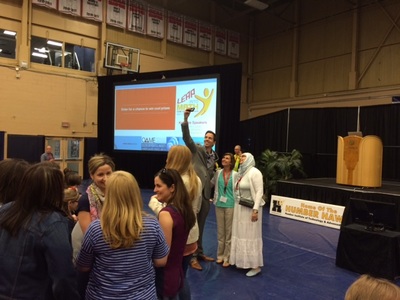He'd genuinely smile and shake hands with his people, then obligingly take their smart phones, put one long arm around the teacher (or group of teachers) and lift up the phone with the other, look engagingly into the camera and smile for the selfie.
In any case, despite his somewhat limited experience as a classroom teacher (after a few years teaching high school math, he is now a PhD candidate at Standford) I must say that Dan Meyer is an engaging and thought-provoking speaker. He used humour to encourage us to examine the myths of student engagement in a way that made his audience more comfortable untangling the misconceptions that many of us had been holding onto, and helped us to consider a more accessible approach for all learners.
Myths of Mathematical Engagement
- The Math has to be "real world"
Dan helped us see how the triangles superimposed on a "real life" photo of the tail of an Orca whale might not convince students to engage with the implied math! - Students must see how the math is relevant to their job in later life
Jose the translator -- who owns a translation business, and whose plea to keep up with math is printed on a page in the middle of a unit in a Grade 9 math textbook -- might be more likely to provoke students to wonder "who the heck is this Jose guy, and why is he in my textbook?" rather than convince the average Grade 9 student to stick with the math!! - We have to make the math "relevant" to students' lives
Dan invited us to consider whether replacing meatballs with spherical ice cubes and a cylindrical spaghetti pot with an ice cap cup from Starbucks was really any more likely to ignite and excite middle school or high school learners to engage with volume and capacity...
Dial it Back Instead
Dan instead suggested "dialing back" the math class vibe, in order to make our lessons more accessible to a wider variety of learners. This could be done with something as simple as an image, or a short video, to draw students in and make them wonder.
Rather than giving students the question, Dan encouraged us to invite questions from the students. Using rich visual provocations could help facilitate such questions. (These can come from textbook questions or pictures, where some information has been removed, for example, covering up the title or headings on a graph.)
Once students have generated questions, said Dan, choose one question to focus on, and ask more questions: Have students share a guess they know is too high, or too low, and invite them to consider how/why they know those are not reasonable estimates.
From there, students can begin to build on their knowledge and understanding to arrive at more reasonable estimates.
Ideally, says Dan, we want to provoke intellectual debate, "start a fight" in our classes, where students want to argue and explain their thinking to prove that their answer is the correct or more reasonable one!
Managing the Dial
While Dan spoke I thought how our job as teachers often centered around managing the dial, so to speak.
Offering multiple entry points and encouraging intellectual debate are both important facets of building an engaging math class, it's true. Equally critical, I would argue, is setting the tone in class and offering specific opportunities to practice disagreeing respectfully, so that -- as the teacher moves the dial forward -- all learners feel comfortable contributing and sharing ideas as they explore their world with math eyes.






 RSS Feed
RSS Feed